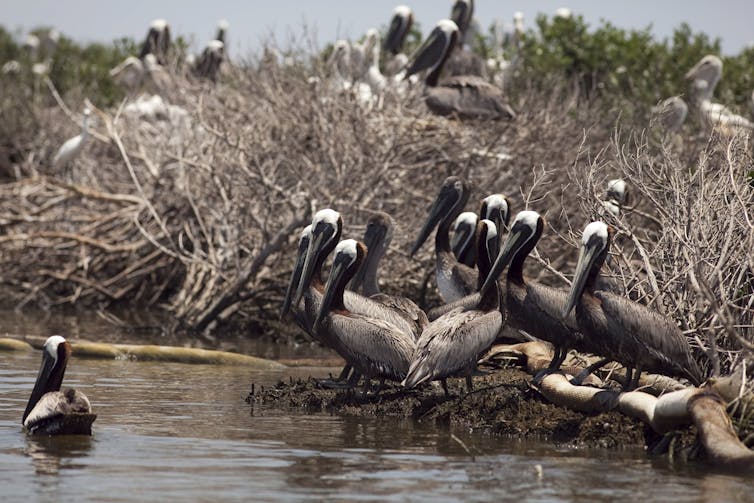The film Deepwater Horizon, starring Mark Wahlberg, captures the chaos and drama that ensued after the massive fireball that engulfed the oil rig of the same name in 2011, which killed 11 people and injured many others. The film dramatises the gruesome ordeal which saw more than 100 crew members battle to survive the inferno of sweltering heat and mayhem.
But the scientific frenzy that followed in the ensuing months was almost as dramatic. And now, just over six years on, there is still much that science has yet to uncover about the spill in the hope of preparing us for the next big one.
Where, for instance, did all the oil actually end up? And what did all the chemicals dumped in the ocean to break up the oil do to the marine life that survived the spill? These questions and more remain unanswered.
The Deepwater Horizon disaster stands in the record books as the largest oil spill in US history. Following the blowout on April 20, 2010, 4.1m barrels (0.7m tonnes) of crude oil leaked into the Gulf of Mexico over a period of almost three months. Only the 1979 Ixtoc-I oil spill, also in the Gulf of Mexico, ranks in the same league.

It was a particularly complex and challenging spill to deal with and study, for several reasons. The exploratory well below Deepwater Horizon was itself an extraordinary engineering feat, the deepest the oil and gas industry had ever drilled in the ocean. The spill occurred about 1.5km below the sea surface, again, the deepest in history. And, because it occurred in such deep water, a good chunk of the oil didn’t rise to the surface as in a usual spill – instead, an unprecedented “oil plume” formed below the surface and lingered there for months.
Rarely has a human-made disaster ever stopped the clock on the research programmes of so many scientists in a nation. Scientists from universities and government-funded agencies all over the US put their work on hold in order to turn their attention to Deepwater Horizon. More than 400 scientific peer-reviewed papers have now been published on the spill, and they’ve revealed a lot of important information.
Within weeks of the spill occurring scientists reported the formation of a massive plume of crude oil a kilometre below the surface that stretched for about 30km and was 300 metres high. It was difficult to track, but nonetheless was intensively studied as researchers realised they had a unique opportunity. Within this oil cloud, scientists also showed that certain types of oil-degrading bacteria had bloomed and that these microbes played a fundamental role in degrading the oil in the deep as well as on sea surface oil slicks of the Gulf.
Research also demonstrated that the oil caused lasting damage to Gulf coast marshes, and that it affected the spawning habitat of Bluefin tuna along the south-east coast of North America.

After the spill, scientists noticed huge quantities of lightly-coloured mucus-like particles or blobs on the sea surface in and around the spill site. These “blobs” could be barely big enough to see, or large enough to fit in your hand. Nothing of this magnitude had been observed before, although there is evidence that similar particles had also formed during the Ixtoc-I spill.
It turned out this was caused by oil sticking to “marine snow” – small specs of dead plankton, bacteria, the mucus they produce, and so on, that clump together near the surface and then fall through the ocean just as real snow falls through the sky. As this “marine oil snow” sank through the water, it took with it a large proportion of the oil from the sea surface and eventually settled on the seabed.
Mysteries remain
Just over six years later, scientists are still trying to understand the full extent of Deepwater Horizon’s impacts on the seabed, beaches and marshes of the Gulf of Mexico. This is actually not a great length of time for science to fully understand a massive and complex spill like this, so its no wonder that some things still remain a mystery.
We know that a lot of the oil from the leaky well that reached the surface made it to the Gulf coast, for instance, and caused acute damage to coastal ecosystems. But we do not know where the deepwater oil plume ended up or what its impact was. Likewise we still don’t know the longer-term impact of the expansive surface oil slicks in the Gulf.
We also need to better understand the impacts of the chemicals that were used to disperse the oil after the spill. Around 7m litres of a dispersant called Corexit was sprayed into the sea by planes or ships. However, given oil dispersant is essentially strong household soap, these chemicals posed a problem for coral and other marine organisms in the Gulf, including the same oil-degrading bacteria that are so critical in the natural bio-degradation process after the spill. Research shows the dispersant used was probably counter-productive.
There is still much to be learnt about what Corexit and other dispersants do to marine life in the longer term. This is important as dispersants are a first line of response to combat oil spills at sea.
Research on the spill is likely to continue for the next few decades. With many oil and gas reservoirs coming to the end of their lives the industry is expanding into the Arctic and other challenging environments, and exploring ever-deeper ocean waters. Another spill like Deepwater Horizon cannot be discounted. What science has already uncovered, and what it will do in years to come, is crucial and should help to better prepare us to deal with the next big one.

